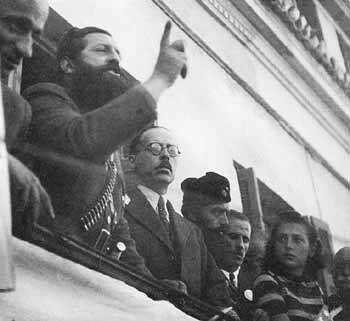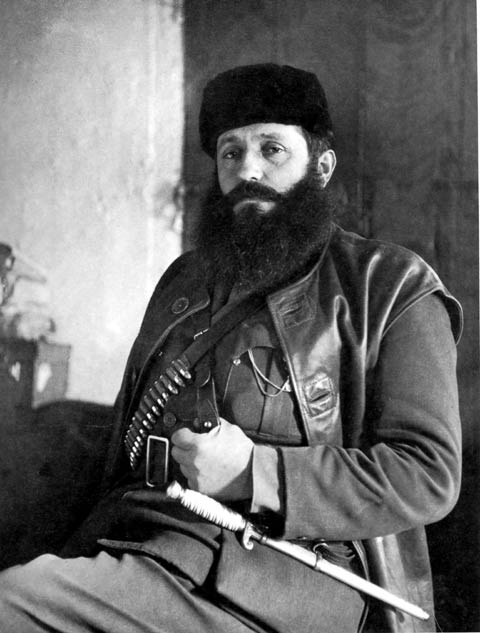<Back to Index>
- Leader of the Greek People's Liberation Army (ELAS) Aris Velouchiotis (Άρης Βελουχιώτης), 1905
PAGE SPONSOR


Aris Velouchiotis (Greek: Άρης Βελουχιώτης), the nom de guerre of Athanasios (Thanasis) Klaras (Greek: Θανάσης Κλάρας, August 27, 1905 – June 16, 1945), was the most prominent leader and chief instigator of the Greek People's Liberation Army (ELAS), the military branch of the National Liberation Front (EAM), which was the major resistance organization in occupied Greece from 1942 to 1945. Aris Velouchiotis was appointed military leader of ELAS at the beginning of the Resistance Movement, by the EAM leadership, being at the same time a member of the Central Committee of the Communist Party of Greece.
Thanasis Klaras was born in Lamia, Greece in 1905, in a family of the upper urban class. His father was a well known lawyer in the area. As a youth, he studied for a while as a journalist and later attended and graduated with enough effort (due to a vagrant youth) from the Geoponic School of Larissa. He participated in the leftist movement and later became a member of the Communist Party of Greece (KKE). During the Ioannis Metaxas dictatorship (1936 – 1941), he was arrested for his communist ideas and jailed in Aegina prison. During his trial, he escaped and joined the (then illegal) Communist Party. He was arrested again in 1939 and was sent to Corfu prison, and remained there until he signed a "statement of renouncement" of the Communist Party, a very humiliating act for a communist at the time.
During World War II, he was drafted as reserve officer of the Hellenic Army but due to undisciplined behavior he was degraded and sent to serve as a corporal to a disciplinary squad of Artillery at the Albanian front (1940 – 1941) against the Italian army, until the German invasion in April 1941 and Greece's subsequent surrender and occupation.
After Germany's offensive campaign in the Soviet Union, the Greek Communist Party championed the creation of the National Liberation Front (EAM), and Klaras was sent to Central Greece (Greek Roumeli) to assess the potential for the development of a guerrilla movement against the occupation forces. His proposals were adopted by the party, and in January 1942, Klaras moved to the mountains to start setting up guerrilla groups.
The first appearance of the partisans organized by Klaras occurred on June 7, 1942 in the village of Domnista in Evritania in Central Greece. There he presented himself as Major of Artillery
(for gaining extra prestige among the villagers) with the nom de guerre
of Aris Velouchiotis (from Ares, the Greek god of war, and Velouchi, a local mountain) and proclaimed the existence of the Greek People's Liberation Army (ELAS).
One of the most important early operations of the Greek resistance movement (in which Velouchiotis and his fighters, after long negotiations with the British, finally agreed to participate alongside Napoleon Zervas's republican EDES resistance forces and twelve British saboteurs under the leadership of Major E.C.W. "Eddie" Myers), was the blowing-up of the Gorgopotamos railway viaduct, south of Lamia, on November 25, 1942 (Operation Harling). The destruction of the viaduct cut the single Thessaloniki - Athens rail line, thus the line connecting the Balkans with southern Greece, but did not disrupt any supply lines - as would have been the case had it happened, as the British intended, two months earlier - for Erwin Rommel's German forces in Northern Africa because it took place one month after the commencement of the El Alamein battle on October 23, 1942, in which Rommel was badly defeated by the British.
The destruction of the Gorgopotamos viaduct was to be the last operation where the communist influenced ELAS organization fought alongside with Greek Republican resistance forces, such as the EKKA's 5/42 Evzones Regiment (military arm of EKKA) and EOEA (National Groups of Greek Guerillas, Εthnikes Omades Ellinon Antarton, military arm of EDES). But despite the signing of an agreement in July 1943 between the three main Resistance groups (EAM - ELAS, EDES and EKKA) to cooperate and to subject themselves to the Allied Middle East High Command under General Wilson (the "National Bands Agreement"), in the political field, the mutual mistrust between EAM and the other groups escalated. EAM - ELAS was by now the dominant political and military force in Greece, and EDES and EKKA, along with the British and the Greek government - in - exile, feared that after the inevitable German withdrawal, it would try to dominate the country and establish a soviet regime The rift ultimately led to a mini - civil war in late 1943 and early 1944, in which ELAS attacked EDES, EOEA and destroyed EKKA's 5/42 Evzones Regiment, savagely executing its leader Col. Dimitrios Psarros.
In October 1944, the Nazis evacuated Greece and a new government was formed under Georgios Papandreou, the leader of the Greek National Unity Government which was established following the Treaties of Lebanon and Caserta. When the Varkiza agreement was signed to end the Dekemvriana fighting
between EAM forces in Athens and governmental forces (with the support
of the British troops), Velouchiotis vehemently refused to comply, in
defiance of the Communist Party leadership, who consequently accused him
of treachery and spurned him as a member of KKE.
Velouchiotis moved again to the mountains of Central Greece in order to start an insurgency (Greek Civil War) against the new government and the British allies who supported them. He was reported to have denounced the sell-out to the British in the 'Varkiza Agreement' to lay down the National Resistance arms; particularly moving was the sight of his elite massed Mavroskoufides (Black Berets) openly mourning. He was outmaneuvered by the KKE leadership and resolved to leave Greece; he repeatedly requested permission from the party to be allowed to be left to depart, but was refused. Though most of his associates abandoned him, he was reported to have continued to conduct guerrilla activities until June 1945. He was denounced by the KKE Central Committee and increasingly isolated until he was ambushed with his unit in the mountain of Agrafa - some say that he was set up or even betrayed by KKE contacts, in 1945 - by paramilitary groups controlled by the Athens government. Although many members of the Security Battalions and the organization 'X' (leader of the X team was the Colonel, at the time, Georgios Grivas), which had collaborated with the German occupying forces, were rounded up and detained in Korydallos Prison in Athens, the majority of their officers were allowed to join the new Greek police force, organized by the British. The new Greek police force was formed under the expert leadership of British officers who had formed the paramilitary organization in Ireland called the 'Black & Tans'.
Aris and his second in command, Leon Javellas, were isolated by the main unit and finally Aris was killed with his comrade either by a hand grenade or by a bullet. Rumors circulated that he "committed suicide with his commander Javellas when his thoughts were that there is no better future for his revolution and its betrayals.".
The corpses of Velouchiotis and his second in command were subsequently decapitated, and the heads displayed, hanging from a lamp post in the central square of the town of Trikala. When British Labor government members of Parliament objected to the barbarity of the operation, they received the reply that the display was in accordance to "Ancient Greek War Custom".
Following the rehabilitation in Greece of the EAM and subsequently of the KKE itself, busts and statues of Aris have been erected in his native town; the KKE moved discreetly for Velouchiotis' rehabilitation, following in turn the expulsion of the KKE's wartime leader who had denounced him, Party Secretary Zahariadis, who had survived incarceration at Dachau.
In a game that only blind luck plays, in an extraordinary coincidence,
the two leaders of the Greek Resistance were distant cousins. Zervas was
a descedant from a the famous Souliote clan of Zervades, who after the
destruction of Souli by the Ottoman Turks fled to Aitoloakarnania, while
Aris Velouchioti's mother was of Souliote descent, from a family
related to Zervades. However, Zervas had never before seen Velouchiotis
before their first meeting during the Resistance era.
Supporters consider Aris Velouchiotis a symbol of Greek resistance against Nazi Germany and a hero of the communist cause. Critics see him as a perpetrator of atrocities and murders against rural people who were perceived as opponents of communism. Velouchiotis is responsible also for the massacre of some one thousand five hundred right wing guerrillas, collaborators from the Security Battalions in Meligala, a village in south - western Peloponnese, in October 1944, right after the German retreat from that part of Greece. His involvement in attacks against non - communist Greek resistance forces and insurgency against the post - liberation government also draw criticism: C.M. Woodhouse remarked that Velouchiotis "fought Greeks more often than he did Germans".
However, he was a man of strong communist and patriotic beliefs, who many times was just executing commands of the leadership of KKE. He was, indeed, especially cruel to Greeks who sought collaboration with the German forces and people who sought the British help and involvement in Greek politics, because they were considered by him as a threat of the communist and patriotic cause of Resistance.